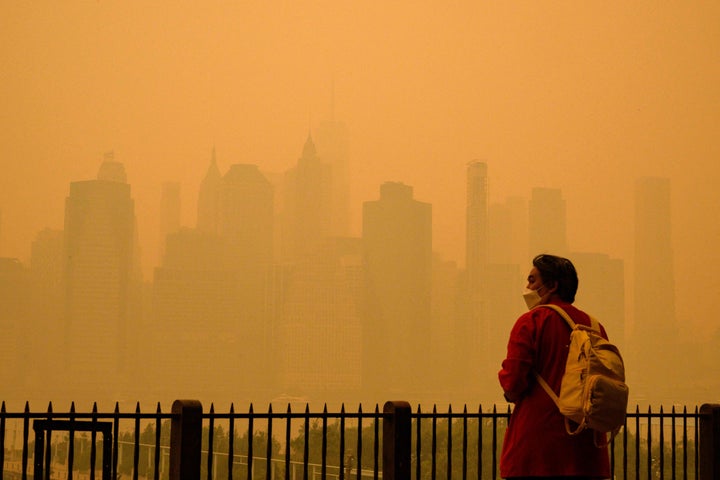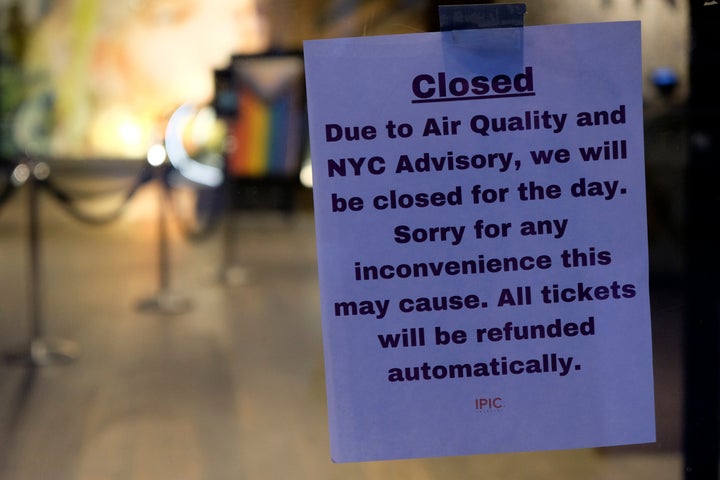
New York, along with much of the US’s northeast coast, is facing an air crisis right now.
Social media is full of photos showing the rather apocalyptic-looking orange skies and a thick cloud seemingly reducing visibility of the city’s iconic skyline.
Like most cities, New York is not known for having especially clean air – but this alarming change seemed to happen overnight, and has now lingered for two days, stretching from the Canadian capital of Ottawa down to Maryland.
Flights have also been cancelled due to the poor visibility, and serious air quality alerts have been issued, with many people encouraged to stay indoors.
So, what’s behind it?
Why is New York orange?
It all stems from wildfires burning across Canada. More than 150 fires are currently raging in Quebec, in the north-east of the country. This is one of the region’s worst wildfire season on record, but there are reportedly only enough firefighters to address 40 of the blazes.
The smoke from these infernos has travelled south, and is now coating much of New York. It’s expected to move further down too, towards Washington DC.
On Wednesday, Canadian prime minister Justin Trudeau said that more than 230 fires are still out of control and more than 20,000 people had been evacuated.
This could end up being Canada’s worse wildfire season ever recorded if it continues – 9.39 million acres of land has burned so far.
The White House has offered to send its support and more than 600 firefighters are en route to help local Canadian communities.

What do the Canadian wildfires mean for the air quality?
More than 75 million people across the east of the US were under air quality alerts as of Wednesday.
Philadelphia, Jersey City in Jersey, and New Haven in Connecticut, all had air quality indexes ranging from 200 to 300, on Wednesday. That’s in the “very unhealthy” range according to the government website, AirNow.gov.
At one point, Detroit city in Michigan was listed as the fifth worst major metropolitan area in the world on IQAir’s air pollution rankings.
New York City was just behind Detroit in the ranks, with an air quality of 484 as of 5pm on Wednesday. That ’s the highest level on record in the metropolis since the 1960s, according to the mayor.
NYC mayor Eric Adams also warned: “It’s difficult to predict the movement of the smoke. This is an unpredictable series of events and we cannot provide guidance more than a day in advance at this point.”
Millions of people across North America has been advised to wear N95 masks (the face masks with respirators) when they’re outside because of the poor air quality, while zoos have brought animals indoors and carriage horse rides have been suspended.
Schools across the area have cancelled outdoor activities, and people have been urged not to exercise outdoors to limit their exposure to the smoke.
New York also began handing out a million free masks on Thursday, although officials have emphasised that it is a “temporary situation”, and that NYC buses and trains have air filtration systems which make them safe.
AirNow.gov also advises: “People with heart or lung disease, older adults, children and teens: Reduce your exposure by avoiding strenuous outdoor activities or keeping outdoor activities short. Consider moving physical activities indoors.
“Everyone else: Reduce your exposure by choosing less strenuous activities or shortening the amount of time you are active outdoors.”
What happens if you breath in wildfire smoke?
Wildfire smoke is especially dangerous because it contains a tiny pollutant, known as PM2.5, which comes from combusting of fossil fuels, dust storms, wildfires.
These small particles in the smoke can enter the blood and go into other parts of the body, which could cause DNA mutations.
The World Health Organisation said in 2016 that around 4.2 million premature deaths were associated with this particulate matter.
“A healthy person may be able to withstand a day or two without too many issues, but at these levels, even they are at risk,” according to Dr Purvi Parikh, allergist and immunologist with NYU Languone Health and Allergy & Asthma Network.
She told CNN: ”But someone who is vulnerable has much higher risk. Most vulnerable include (the) elderly, children, those with underlying lung issues like asthma, COPD, lung cancer, heart disease and pregnant women.”
If symptoms remain even once the air quality returns to normal levels, Dr Parikh warned: “They may have developed asthma or COPD as a result, and that can become chronic.”
In the short-term, it can also cause shortness of breath, elevated pulse, chest pain and inflammation in the eyes, nose and throat.
Why is it especially bad this year?
Canada has wildfires every year, but 2023 is shaping up to be especially damaging because the country had a drier and warmer spring. This created conditions where fires could thrive.
Wildfires have already consumed 9.4 million acres of land, which is 12 times the 10-year average for June.
Climate change means the global temperatures have already increased by 1.2C since the industrial era, meaning extreme weather events like this are more likely.
Scientists also reported in May that more than a third of the area affected by wildfires in North America can be traced back to human-produced fossil fuels.
What next?
Canada has confirmed that conditions are only getting worse in Toronto.
Meanwhile, the smog is likely to stay over the US’s northeast until at least the weekend, potentially moving through the mid-Atlantic and reaching North Carolina and South Carolina.
